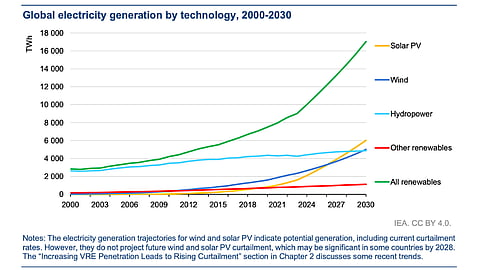

IEA’s new report sees huge potential for the world’s renewable energy growth, led by solar PV and followed by wind energy
China will continue to remain the undisputed leader in this space, even as the other big markets of the EU, US and India expand their respective capacities
This growth still won’t be enough for the world to triple its renewable energy capacity as targeted by 2030
Bold plans, increased international cooperation and financing in developing and emerging markets need of the hour
Between 2024 and 2030, the world is set to add over 5,500 GW of new renewable energy capacity, with solar PV alone accounting for 80% of these additions thanks to the construction of several large-scale solar and rooftop solar power plants, according to a new International Energy Agency (IEA) report.
Solar PV will become the largest renewable energy power generation source by the end of this decade, surpassing both wind and hydropower in the report’s main case scenario.
This translates into the addition of almost 940 GW of renewable capacity annually by 2030, with solar PV and wind energy accounting for 95% of all growth through the end of this decade. In 2023, in comparison, the global annual renewable energy capacity additions increased by more than 60% to almost 565 GW and are forecast to increase to 666 GW this year.
China will continue to be the global renewables leader with 60% of expansion sited in the country. As per the report Renewables 2024 Analysis and forecast to 2030, China is forecast to be home to every other megawatt of all renewable energy capacity installed worldwide in 2030, after surpassing its end-of-the-decade 1,200 GW target for solar PV and wind 6 years early (see China Hits 2030 Wind & Solar PV Capacity Target 6 Years Earlier).
The European Union (EU) will see its 600 GW solar PV capacity target for 2030 within reach thanks to competitive auctions and corporate power purchase agreements (PPA). The US will continue to forge ahead powered by the Inflation Reduction Act (IRA).
The introduction of PM Surya Ghar: Muft Bijli Yojana, the new rooftop solar scheme, and continued focus on auctions will drive India’s renewable energy growth.
Wind energy will also get a boost as the IEA expects it to recover from financial challenges with Europe, the US, India and other countries bringing in a supportive regulatory environment. However, other renewables are expected to decline due to a lack of policy support.
In fact, the report sees hydrogen as a ‘negligible driver’ for new renewable capacity growth and expects hydrogen produced with renewable energy to account for only 4% of total hydrogen production in 2030.
IEA Executive Director Fatih Birol believes that the reason why renewables are moving faster than national governments can set targets for is because renewables are now the cheapest power generation option globally.
“This report shows that the growth of renewables, especially solar, will transform electricity systems across the globe this decade,” added Birol. “Between now and 2030, the world is on course to add more than 5 500 gigawatts of renewable power capacity – roughly equal the current power capacity of China, the European Union, India and the United States combined. By 2030, we expect renewables to be meeting half of global electricity demand.”
Overall, nearly 70 countries that collectively account for 80% of global renewable power capacity are poised to reach or surpass their current renewable ambitions for 2030.
Challenges and solutions
Yet, all these measures will not be enough to meet the COP28 goal of tripling the world’s renewable energy capacity by the end of this decade. Meeting this target is however ‘entirely possible’ but will require ‘bold plans’ in the next round of Nationally Determined Contributions (NDC) under the Paris Agreement in 2025.
Additionally, the world will need to ensure increased cooperation to bring down high financing costs in emerging and developing economies. The lack of sufficient and equally distributed financing is ‘restraining’ renewables’ growth in the high-potential regions of Africa and Southeast Asia, according to the report writers.
In terms of grid infrastructure, the increasing share of wind and solar PV generation is leading to high curtailment, which now points to the need for flexibility. The report counts a minimum of 1,650 GW of renewable capacity at advanced stages of development and waiting for grid connection, but the lack of progress is leading to some projects dropping out of the queues.
For solar PV, the IEA analysts point to the scaling back of investment plans by manufacturers marred by oversupply and record-low prices. By the end of 2024, the world is likely to have more than 1,100 GW of solar PV manufacturing capacity, more than double the projected PV demand.
As much as 300 GW of polysilicon and 200 GW of wafer manufacturing projects worth $25 billion have so far been canceled owing to these reasons. The IEA anticipates 17% of the global polysilicon and 10% of wafer manufacturing capacity at risk due to age and suboptimal production processes.
Even though the US and India are forecast to almost triple their cell and module production capacity by 2030, manufacturing PV modules in these 2 countries remains 2 to 3 times more expensive than in China, a gap that is likely to remain in place for the foreseeable future.
The complete IEA report is available for free download on its website.
The IEA’s report echoes the concern expressed by IRENA in its recent report in which it claimed that the tripling of the renewable energy target will not be possible if the annual rate of growth for renewables does not increase from 10% in 2023 to 16.4% (see RE Must Grow At 16.4 Percent Annual Rate Through 2030).
